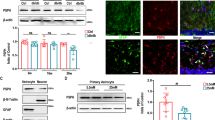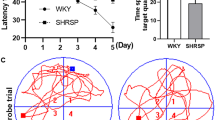Abstract
Curcumin (Cur) is widely used as an anti-inflammation agent and has anti-depression potential. Neuroinflammation mediated by Ca2+ channel activation is closely associated with the progression of post-stroke depression (PSD). In the current study, the role of P2X7 receptor (P2X7R) in the anti-PSD function of Cur was explored. Rats were subjected to middle cerebral artery occlusion (MCAO) surgery and chronic mild stress administration to induce PSD symptoms and then treated with Cur. The behaviors of rats were assessed with sucrose preference and forced swim tests. The accumulation of Ca2+ and the systemic inflammatory response in rats were detected. To determine the role of P2X7R in the anti-PSD function of curcumin, the PSD mice were further administrated with P2X7R agonist and antagonist. The administration of Cur attenuated behavior disorders associated with PSD. Moreover, the Ca2+ accumulation and the inflammatory response associated with PSD were also blocked by Cur. Cur also inhibited the activation of Ca2+ channel. The induced activity of P2X7R blocked the function of Cur by maintaining the symptoms of PSD in Cur-treated rats. Collectively, the anti-PSD function of Cur was dependent on the inhibition of P2X7R, which then deactivated Ca2+ channel-mediated inflammatory response associated with PSD progression.





Similar content being viewed by others
Change history
05 April 2024
This article has been retracted. Please see the Retraction Notice for more detail: https://doi.org/10.1007/s11010-024-05003-2
References
Hackett ML, Yapa C, Parag V, Anderson CS (2005) Frequency of depression after stroke: a systematic review of observational studies. Stroke 36(6):1330–1340. https://doi.org/10.1161/01.STR.0000165928.19135.35
Ayerbe L, Ayis S, Wolfe CD, Rudd AG (2013) Natural history, predictors and outcomes of depression after stroke: systematic review and meta-analysis. Brit J Psychiatry 202(1):14–21. https://doi.org/10.1192/bjp.bp.111.107664
Hackett ML, Anderson CS, House A, Xia J (2008) Interventions for treating depression after stroke. Cochrane Database Syst Rev. https://doi.org/10.1002/14651858.cd003437.pub3
Winstein CJ, Stein J, Arena R, Bates B, Cherney LR, Cramer SC, Deruyter F, Eng JJ, Fisher B, Harvey RL, Lang CE, MacKay-Lyons M, Ottenbacher KJ, Pugh S, Reeves MJ, Richards LG, Stiers W, Zorowitz RD (2016) Guidelines for adult stroke rehabilitation and recovery: a guideline for healthcare professionals from the American Heart Association/American Stroke Association. Stroke 47(6):e98–e169. https://doi.org/10.1161/STR.0000000000000098
Loubinoux I, Kronenberg G, Endres M, Schumann-Bard P, Freret T, Filipkowski RK, Kaczmarek L, Popa-Wagner A (2012) Post-stroke depression: mechanisms, translation and therapy. J Cell Mol Med 16(9):1961–1969. https://doi.org/10.1111/j.1582-4934.2012.01555.x
Kiecolt-Glaser JK, Derry HM, Fagundes CP (2015) Inflammation: depression fans the flames and feasts on the heat. Am J Psychiatry 172(11):1075–1091. https://doi.org/10.1176/appi.ajp.2015.15020152
Howren MB, Lamkin DM, Suls J (2009) Associations of depression with C-reactive protein, IL-1, and IL-6: a meta-analysis. Psychosom Med 71(2):171–186. https://doi.org/10.1097/PSY.0b013e3181907c1b
Dowlati Y, Herrmann N, Swardfager W, Liu H, Sham L, Reim EK, Lanctot KL (2010) A meta-analysis of cytokines in major depression. Biol Psychiatry 67(5):446–457. https://doi.org/10.1016/j.biopsych.2009.09.033
Liu Yang, Ho Chunman R, Mak Anselm (2012) Interleukin (IL)-6, tumour necrosis factor alpha (TNF-α) and soluble interleukin-2 receptors (sIL-2R) are elevated in patients with major depressive disorder: A meta-analysis and meta-regression. J Affect Disord 139(3):230–239
Yirmiya R, Rimmerman N, Reshef R (2015) Depression as a Microglial Disease. Trends Neurosci 38(10):637–658
Tremblay ME, Stevens B, Sierra A, Wake H, Bessis A, Nimmerjahn A (2011) The role of microglia in the healthy brain. J Neurosci 31(45):16064–16069. https://doi.org/10.1523/JNEUROSCI.4158-11.2011
Wake H, Moorhouse AJ, Miyamoto A, Nabekura J (2013) Microglia: actively surveying and shaping neuronal circuit structure and function. Trends Neurosci 36(4):209–217. https://doi.org/10.1016/j.tins.2012.11.007
Huang BR, Chang PC, Yeh WL, Lee CH, Tsai CF, Lin C, Lin HY, Liu YS, Wu CY, Ko PY, Huang SS, Hsu HC, Lu DY (2014) Anti-neuroinflammatory effects of the calcium channel blocker nicardipine on microglial cells: implications for neuroprotection. PLoS ONE 9(3):e91167. https://doi.org/10.1371/journal.pone.0091167
Liu Y, Lo YC, Qian L, Crews FT, Wilson B, Chen HL, Wu HM, Chen SH, Wei K, Lu RB (2011) Verapamil protects dopaminergic neuron damage through a novel anti-inflammatory mechanism by inhibition of microglial activation. Neuropharmacology 60(2–3):373–380
Srimal RC, Dhawan BN (1973) Pharmacology of diferuloyl methane (curcumin), a non-steroidal anti-inflammatory agent. J Pharm Pharmacol 25(6):447–452. https://doi.org/10.1111/j.2042-7158.1973.tb09131.x
Satoskar RR, Shah SJ, Shenoy SG (1986) Evaluation of anti-inflammatory property of curcumin (diferuloyl methane) in patients with postoperative inflammation. Int J Clin Pharmacol Ther Toxicol 24(12):651–654
Sharma OP (1976) Antioxidant activity of curcumin and related compounds ☆. Biochem Pharmacol 25(15):1811–1812
Seo JA, Kim B, Dhanasekaran DN, Tsang BK, Song YS (2016) Curcumin induces apoptosis by inhibiting sarco/endoplasmic reticulum Ca2 + ATPase activity in ovarian cancer cells. Cancer Lett 371(1):30–37. https://doi.org/10.1016/j.canlet.2015.11.021
Zhang WY, Guo YJ, Han WX, Yang MQ, Wen LP, Wang KY, Jiang P (2019) Curcumin relieves depressive-like behaviors via inhibition of the NLRP3 inflammasome and kynurenine pathway in rats suffering from chronic unpredictable mild stress. Int Immunopharmacol 67:138–144. https://doi.org/10.1016/j.intimp.2018.12.012
Gombault A, Baron L, Couillin I (2013) ATP release and purinergic signaling in NLRP3 inflammasome activation. Front Immunol 3:414
Madiha S, Haider S (2019) Curcumin restores rotenone induced depressive-like symptoms in animal model of neurotoxicity: assessment by social interaction test and sucrose preference test. Metab Brain Dis 34(1):297–308. https://doi.org/10.1007/s11011-018-0352-x
Porsolt RD, Anton G, Blavet N, Jalfre M (1978) Behavioural despair in rats: a new model sensitive to antidepressant treatments. Eur J Pharmacol 47(4):379–391. https://doi.org/10.1016/0014-2999(78)90118-8
Ng QX, Ssh K, Chan HW, Cyx H (2017) Clinical use of curcumin in depression: a meta-analysis. J Am Med Dir Assoc 18(6):503–508
Kaufmann FN, Gazal M, Bastos CR, Kaster MP, Ghisleni G (2016) Curcumin in depressive disorders: an overview of potential mechanisms, preclinical and clinical findings. Eur J Pharmacol 784:192–198
Farzanfar D, Dowlati Y, French LE, Lowes MA, Alavi A (2018) Inflammation: a contributor to depressive comorbidity in inflammatory skin disease. Skin Pharmacol Physiol 31(5):246–251. https://doi.org/10.1159/000490002
Czeh M, Gressens P, Kaindl AM (2011) The yin and yang of microglia. Dev Neurosci-Basel 33(3–4):199–209. https://doi.org/10.1159/000328989
Wee Yong V (2010) Inflammation in neurological disorders: a help or a hindrance? Neuroscientist 16(4):408–420. https://doi.org/10.1177/1073858410371379
Ziv Y, Ron N, Butovsky O, Landa G, Sudai E, Greenberg N, Cohen H, Kipnis J, Schwartz M (2006) Immune cells contribute to the maintenance of neurogenesis and spatial learning abilities in adulthood. Nat Neurosci 9(2):268–275. https://doi.org/10.1038/nn1629
North RA (2002) Molecular physiology of P2X receptors. Physiol Rev 82(4):1013–1067. https://doi.org/10.1152/physrev.00015.2002
Khakh BS, R Alan N (2006) P2X receptors as cell-surface ATP sensors in health and disease. Nature 442 (7102):527-532
Dubyak GR (2007) Go it alone no more–P2X7 joins the society of heteromeric ATP-gated receptor channels. Mol Pharmacol 72(6):1402–1405
Funding
This study was supported by the grants from the Science and Technology Research Project of Henan Province (172102310585).
Author information
Authors and Affiliations
Corresponding author
Ethics declarations
Conflict of interest
The authors disclose no conflict of interest.
Additional information
Publisher's Note
Springer Nature remains neutral with regard to jurisdictional claims in published maps and institutional affiliations.
Zhen Wang and Kui Jia have contributed equally to this work.
This article has been retracted. Please see the retraction notice for more detail: https://doi.org/10.1007/s11010-024-05003-2"
Electronic supplementary material
Below is the link to the electronic supplementary material.
Rights and permissions
Springer Nature or its licensor (e.g. a society or other partner) holds exclusive rights to this article under a publishing agreement with the author(s) or other rightsholder(s); author self-archiving of the accepted manuscript version of this article is solely governed by the terms of such publishing agreement and applicable law.
About this article
Cite this article
Wang, Z., Ren, W., Zhao, F. et al. RETRACTED ARTICLE: Curcumin amends Ca2+ dysregulation in microglia by suppressing the activation of P2X7 receptor. Mol Cell Biochem 465, 65–73 (2020). https://doi.org/10.1007/s11010-019-03668-8
Received:
Accepted:
Published:
Issue Date:
DOI: https://doi.org/10.1007/s11010-019-03668-8




